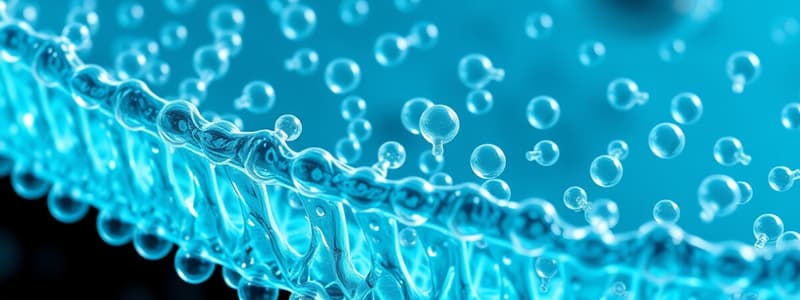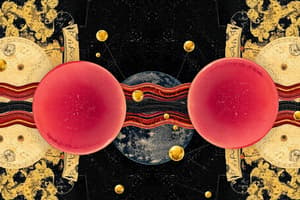Podcast
Questions and Answers
The class of organic molecules that does not typically form polymers are the:
The class of organic molecules that does not typically form polymers are the:
lipids
Which of these choices is due to the ability of phospholipids to spontaneously form macromolecular structures when added to an aqueous solution?
Which of these choices is due to the ability of phospholipids to spontaneously form macromolecular structures when added to an aqueous solution?
- The ability of vesicles to bud off from the plasma membrane (endocytosis) (correct)
- The ability of vesicles to fuse with the plasma membrane (exocytosis) (correct)
- The formation of lipid bilayers (correct)
- All of these choices are correct (correct)
Which component of a phospholipid is found in the interior of a lipid bilayer?
Which component of a phospholipid is found in the interior of a lipid bilayer?
fatty acids
The interior region of a phospholipid bilayer is characterized as:
The interior region of a phospholipid bilayer is characterized as:
A phospholipid molecule in a membrane can:
A phospholipid molecule in a membrane can:
Although the phospholipid molecules can be in constant lateral movement, they very rarely flip from one side of the bilayer to the other. What could explain this?
Although the phospholipid molecules can be in constant lateral movement, they very rarely flip from one side of the bilayer to the other. What could explain this?
Predict how phospholipids would arrange if they were placed in a nonpolar solution rather than a polar solution like water.
Predict how phospholipids would arrange if they were placed in a nonpolar solution rather than a polar solution like water.
Which choice is considered an integral membrane protein?
Which choice is considered an integral membrane protein?
A protein that is found in the Golgi apparatus was synthesized:
A protein that is found in the Golgi apparatus was synthesized:
Where must the SRP receptor be located in a cell?
Where must the SRP receptor be located in a cell?
Consider the events that describe the progress of a protein that will be secreted from the cell. Identify the correct sequence of events:
Consider the events that describe the progress of a protein that will be secreted from the cell. Identify the correct sequence of events:
Which molecule would most likely require a transport protein to cross the plasma membrane of a red blood cell?
Which molecule would most likely require a transport protein to cross the plasma membrane of a red blood cell?
Why does active transport of molecules across a membrane require ATP?
Why does active transport of molecules across a membrane require ATP?
Flashcards are hidden until you start studying
Study Notes
Lipids and Polymers
- Lipids are a class of organic molecules that typically do not form polymers.
Phospholipids in Aqueous Solutions
- Phospholipids spontaneously form macromolecular structures in water, leading to lipid bilayers.
- This phenomenon allows vesicles to bud off (endocytosis) and fuse with the plasma membrane (exocytosis).
- It is essential for the formation of the first cells.
Structure of Phospholipids
- The interior of a lipid bilayer consists of fatty acids, which are nonpolar and excluded from interactions with water.
- The hydrophobic nature of the lipid bilayer's interior characterizes it as such.
Movement of Phospholipids
- Phospholipid molecules can rotate and move laterally within the membrane.
- They rarely flip from one side to the other, as their head groups are repelled by the hydrophobic interior.
Phospholipids in Nonpolar Solutions
- In a nonpolar solution, phospholipid tails orient towards the solution, while heads cluster away.
Integral Membrane Proteins
- Integral membrane proteins, like transmembrane proteins, have amino-termini in the cytoplasm and carboxy-termini in the extracellular space and span the membrane.
Protein Synthesis and Transport
- Proteins found in the Golgi apparatus are synthesized on ribosomes attached to the rough endoplasmic reticulum (ER).
SRP Receptor Location
- The signal recognition particle (SRP) receptor must be located in the rough ER membrane to facilitate protein translation.
Sequence of Protein Secretion Events
- The sequence of protein secretion is as follows:
- Protein synthesis begins in the cytosol.
- SRP binds to the polypeptide and ribosome, leading to translation resuming.
- SRP binds to its receptor, and the signal sequence is cleaved.
Transport of Molecules Across Membrane
- Glucose (C6H12O6), a larger and more polar molecule, likely requires a transport protein to cross the plasma membrane of red blood cells.
Active Transport and ATP
- Active transport requires ATP because it moves molecules from low to high concentration against the gradient, which needs energy input.
Studying That Suits You
Use AI to generate personalized quizzes and flashcards to suit your learning preferences.



